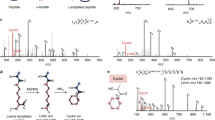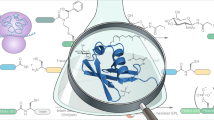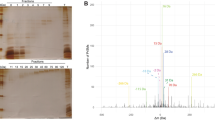Abstract
To improve proteome coverage and protein C-terminal identification, we characterized the Methanosarcina acetivorans thermophilic proteinase LysargiNase, which cleaves before lysine and arginine up to 55 °C. Unlike trypsin, LysargiNase-generated peptides had N-terminal lysine or arginine residues and fragmented with b ion–dominated spectra. This improved protein C terminal–peptide identification and several arginine-rich phosphosite assignments. Notably, cleavage also occurred at methylated or dimethylated lysine and arginine, facilitating detection of these epigenetic modifications.
This is a preview of subscription content, access via your institution
Access options
Subscribe to this journal
Receive 12 print issues and online access
$259.00 per year
only $21.58 per issue
Buy this article
- Purchase on Springer Link
- Instant access to full article PDF
Prices may be subject to local taxes which are calculated during checkout


Similar content being viewed by others
Accession codes
References
Tabb, D.L., Huang, Y., Wysocki, V.H. & Yates, J.R. III. Anal. Chem. 76, 1243–1248 (2004).
Hohmann, L. et al. J. Proteome Res. 8, 1415–1422 (2009).
Schilling, O., Barré, O., Huesgen, P.F. & Overall, C.M. Nat. Methods 7, 508–511 (2010).
Van Damme, P. et al. Nat. Methods 7, 512–515 (2010).
Gomis-Rüth, F.X. Crit. Rev. Biochem. Mol. Biol. 43, 319–345 (2008).
Snijders, A.P.L., Hung, M.-L., Wilson, S.A. & Dickman, M.J. J. Am. Soc. Mass Spectrom. 21, 88–96 (2010).
Lange, P.F., Huesgen, P.F., Nguyen, K. & Overall, C.M. J. Proteome Res. 13, 2028–2044 (2014).
Taouatas, N., Drugan, M.M., Heck, A.J.R. & Mohammed, S. Nat. Methods 5, 405–407 (2008).
Gauci, S. et al. Anal. Chem. 81, 4493–4501 (2009).
Taouatas, N. et al. Mol. Cell. Proteomics 8, 190–200 (2009).
Taouatas, N., Heck, A.J.R. & Mohammed, S. J. Proteome Res. 9, 4282–4288 (2010).
Raijmakers, R., Neerincx, P., Mohammed, S. & Heck, A.J.R. Chem. Commun. (Camb.) 46, 8827–8829 (2010).
Tallant, C., García-Castellanos, R., Seco, J., Baumann, U. & Gomis-Rüth, F.X. J. Biol. Chem. 281, 17920–17928 (2006).
Tallant, C. et al. Biol. Chem. 388, 1243–1253 (2007).
Vandermarliere, E., Mueller, M. & Martens, L. Mass Spectrom. Rev. 32, 453–465 (2013).
Waldera-Lupa, D.M., Stefanski, A., Meyer, H.E. & Stühler, K. Biochim. Biophys. Acta 1834, 2843–2848 (2013).
Rogers, L.D., Brown, N.F., Fang, Y., Pelech, S. & Foster, L.J. Sci. Signal. 4, rs9 (2011).
Schwartz, D. & Gygi, S.P. Nat. Biotechnol. 23, 1391–1398 (2005).
Mochly-Rosen, D., Das, K. & Grimes, K.V. Nat. Rev. Drug Discov. 11, 937–957 (2012).
Schilling, O. & Overall, C.M. Nat. Biotechnol. 26, 685–694 (2008).
Kleifeld, O. et al. Nat. Protoc. 6, 1578–1611 (2011).
Pettersen, E.F. et al. J. Comput. Chem. 25, 1605–1612 (2004).
Gomis-Rüth, F.X., Botelho, T.O. & Bode, W. Biochim. Biophys. Acta 1824, 157–163 (2012).
Boersema, P.J., Raijmakers, R., Lemeer, S., Mohammed, S. & Heck, A.J.R. Nat. Protoc. 4, 484–494 (2009).
Wessel, D. & Flügge, U.I. Anal. Biochem. 138, 141–143 (1984).
Rappsilber, J., Mann, M. & Ishihama, Y. Nat. Protoc. 2, 1896–1906 (2007).
Schilling, O., Huesgen, P.F., Barré, O., Auf dem Keller, U. & Overall, C.M. Nat. Protoc. 6, 111–120 (2011).
Olsen, J.V. et al. Mol. Cell. Proteomics 4, 2010–2021 (2005).
Cox, J. et al. J. Proteome Res. 10, 1794–1805 (2011).
Cox, J. & Mann, M. Nat. Biotechnol. 26, 1367–1372 (2008).
Craig, R. & Beavis, R.C. Bioinformatics 20, 1466–1467 (2004).
Keller, A., Nesvizhskii, A.I., Kolker, E. & Aebersold, R. Anal. Chem. 74, 5383–5392 (2002).
Shteynberg, D. et al. Mol. Cell. Proteomics 10, M111.007690 (2011).
Keller, A. & Shteynberg, D. Methods Mol. Biol. 694, 169–189 (2011).
Eng, J.K., Jahan, T.A. & Hoopmann, M.R. Proteomics 13, 22–24 (2013).
Chou, M.F. & Schwartz, D. Curr. Protoc. Bioinformatics 35, 13.15 (2011).
Keshava Prasad, T.S. et al. Nucleic Acids Res. 37, D767–D772 (2009).
Colaert, N., Helsens, K., Martens, L., Vandekerckhove, J. & Gevaert, K. Nat. Methods 6, 786–787 (2009).
Spitzer, M., Wildenhain, J., Rappsilber, J. & Tyers, M. Nat. Methods 11, 121–122 (2014).
Acknowledgements
We thank N. Stoynov and J. Rogalski for mass spectrometry data acquisition, and N. Scott and A. Frankel (both University of British Columbia) for stimulating discussions and providing the R1 peptides. We thank G. Butler for valuable editorial input. The German Academic Exchange Service (DAAD) and the Michael Smith Foundation for Health Research (MSFHR) supported P.F.H. P.F.L. was supported by the Alexander von Humboldt Foundation, Breast Cancer Society of Canada and MSFHR; L.D.R. was supported by the Canadian Institutes for Health Research (CIHR) and MSFHR; and U.E. was supported by the MSFHR. This work was supported by a Canada Research Chair in Metalloproteinase Proteomics and Systems Biology (C.M.O.), a grant from the CIHR (grant number M.O.P. 111055) as well as by an Infrastructure Grant from MSFHR and the Canada Foundations for Innovation (C.M.O.). Further support was provided by the European Union FP7 program; Consolider Program of the Spanish Ministry of Science and Technology; and State Plan for Research in Science, Technology and Innovation of the Spanish Ministry of Economy and Competitiveness (F.X.G.-R.).
Author information
Authors and Affiliations
Contributions
P.F.H. and C.M.O. conceived of the experiments. T.G. and F.X.G.-R. produced the recombinant LysargiNase and structural models, P.F.H. performed all shotgun and PICS analyses, P.F.H. and L.D.R. performed the phosphosite experiments, N.S. and U.E. performed in-gel digests, and U.E. performed exopeptidase experiments. O.K. provided access to a QExactive instrument and performed mass spectrometer analysis of phosphopeptides; P.F.H., P.F.L., L.D.R., N.S. and C.M.O. analyzed the data; P.F.H., P.F.L. and C.M.O. designed the figures; L.D.R., N.S. and U.E. contributed to Supplementary Figures;P.F.H. and C.M.O. wrote the paper; and all authors edited the manuscript. C.M.O. supervised the project and provided grant support.
Corresponding author
Ethics declarations
Competing interests
P.F.H., F.X.G.-R. and C.M.O. are pursuing negotiations for commercial distribution of LysargiNase.
Integrated supplementary information
Supplementary Figure 1 Characterization of LysargiNase, trypsin and LysN missed cleavages.
(a) Proportion of peptides identified in LysargiNase and trypsin digests of MDA-MB-231 cell lysates carrying 0, 1, 2 or 3 missed cleavage sites using enzyme-specific settings for peptide-to-sequence matching. IceLogos showing (b) unique cleavage sites, inferred from both ends of peptides identified in LysargiNase or trypsin-digested MDA-MB-231 proteomes (this study) or from peptides identified in Lys-N digested HEK293 cell lysates reported by Raijmakers et al.12 and (c, d) the sequence context surrounding missed LysargiNase or trypsin cleavage sites at Arg or Lys and missed Lys-N cleavages sites at Lys. Shown are significant differences in occurrence (P < 0.05) as compared to (b,c) the natural amino acid abundance in the human proteome and (d) specific cleavage sites identified for each enzyme.
Supplementary Figure 2 LysargiNase activity in common proteomics conditions and solutions and at different temperatures.
LysargiNase activity was assayed after 30 min incubation with resorufin-labeled casein (enzyme:substrate ratio 1:400 w/w) at 37 °C in 50 mM HEPES, 10 mM CaCl2, pH 7.5 with added indicated concentrations of (a) NaCl and reducing agents DTT and TCEP, (b) organic solvents methanol (MeOH) and acetonitrile (ACN), (c) the detergent RapiGestTM and denaturing concentrations of urea and (d) denaturing chaotropic agents urea with thiourea and guanidine alone. Significance of difference to incubation at control conditions was tested with two-tailed Student’s t-test (n = 3, * p < 0.05). (e) Incomplete LysargiNase digestion of human MDA-MB-231 cell lysate at 37 °C under enzyme-limited conditions (enzyme:proteome 1:100 w/w) so as to semi-quantitatively monitor differences in proteome digest in the presence of detergents, organic solvents and reducing agents. Note that enzymatic activity in the presence of reducing agents is restored by quenching with the alkylating reagent iodoacetamide (IAM) added after reduction. (g) LysargiNase activity assayed after 30 min incubation with resorufin-labeled casein substrate (enzyme:substrate ratio 1:400 w/w) in 50 mM Hepes, 10 mM CaCl2, pH 7.5 at the indicated temperatures. Significance of difference to incubation at 25 °C was tested with two-tailed Student’s t-test (n = 6, * p < 0.05). (h) Comparison of human MDA-MB-231 cell lysates digestion with LysargiNase at different enzyme:proteome ratios at 37 °C and 50 °C.
Supplementary Figure 3 MALDI-TOF–based exopeptidase activity assay with synthetic peptides.
The synthetic peptides (a) RGPANL↓KGR, (b) RGISEVNLDAEF↓RH, and (c) RGPANLIG↓R were used to assay tri-, di- and mono-carboxypeptidase activities of LysargiNase, respectively. Peptides were analyzed by MALDI-TOF mass spectrometry after over-night incubation with (w/w 50:1; right panels) and without (left panels) LysargiNase. The cleavage product of RGPANLIG↓R was subsequently analyzed using a MALDI TOF/TOF tandem mass spectrometer, revealing a fragmentation spectrum dominated by b-series ions with a prominent arginine b1 ion (m/z 157) and no arginine y1 ion (m/z 175), ruling out aminopeptidase activity (not shown).
Supplementary Figure 4 MALDI-TOF–based exopeptidase activity assay.
(a) A tryptic BSA digest was used to (b) assay LysargiNase for amino- and carboxypeptidase activities. No aminopeptidase activity was observed, but two peptides (m/z 689.3260 and 1439.8773, indicated in blue) out of 10 tryptic BSA peptides were C-terminally processed indicating minor arginyl-carboxypeptidase activity. A LysargiNase autolytic peptide was observed (REMPMPR, m/z 916.3680; indicated in black).
Supplementary Figure 5 In-gel digests of bovine β-casein and BSA.
Peptides identified by LC-MS/MS using beam-type CID after in-gel digestion of bovine beta-casein with (a) LysargiNase or (b) trypsin and bovine serum albumin with (c) LysargiNase or (d) trypsin. Peptides identified by Mascot database searches are highlighted in red, Mascot protein identification score and sequence coverage are indicated.
Supplementary Figure 6 Complementarity of LysargiNase and trypsin in shotgun proteomics.
(a) Box plots of the ratios of b-type to y-type fragment ions observed in 8,463 ion trap CID peptide spectrum matches for trypsin and 5,474 for LysargiNase (FDR < 0.01). The centerlines show the medians, box limits indicate the 25th and 75th percentiles, whiskers extend to the 5th and 95th percentiles, and outliers are represented by dots. Significance of the difference was tested using the two-tailed Student’s t-test (*** P < 0.001). (b) Overlap of peptide sequences identified after trypsin or LysargiNase cleavage of proteomes. For comparison, N- or C-terminal basic residues were removed from the peptide sequences identified from LysargiNase and trypsin datasets, respectively.
Supplementary Figure 7 Examples of peptide fragmentation spectra with overlapping sequences but differential placement of identical basic residues.
(a-d) Peptide ion trap CID fragmentation spectra from LysargiNase-digested MDA-MB-231 cell lysates peptides (left panels) and corresponding peptide fragmentation spectra from trypsin-digested MDA-MB-231 cell lysates covering the same protein sequence (right panels). Spectra are shown as matched to peptide sequences and annotated by MaxQuant v1.4.12.
Supplementary Figure 8 Examples of peptide fragmentation spectra with overlapping sequences but differential placement of varying basic residues.
(a-d) Peptide ion trap CID fragmentation spectra from LysargiNase-digested MDA-MB-231 cell lysates peptides (left panels) and corresponding peptide fragmentation spectra from trypsin-digested MDA-MB-231 cell lysates covering the same protein sequence (right panels). Spectra are shown as matched to peptide sequences and annotated by MaxQuant v1.4.12.
Supplementary Figure 9 Effect of a-ion fragments on spectral quality and Comet XCORR scores.
(a) Beam-type CID MS/MS spectra of the LysargiNase peptide RLLVDCYSPVE (top panel) and corresponding tryptic peptide LLVDCYSPVER (bottom panel). The tryptic peptide exhibits strong and extensive y-type fragment ions whereas the LysargiNase-derived peptide exhibits strong b-type and a-type fragment ions. (b) Increase in Comet XCORR score by inclusion of a-type fragment ions during peptide-to-sequence matching of beam-type CID fragmentation spectra, plotted as % increase. Inclusion of a-type fragment ions increased scores for LysargiNase-derived peptides by 33% (left panel), significantly stronger than for tryptic peptides (right panel), where scores increased only by 15% (P < 0.0001, two sided Student’s t-test, one of two replicates shown). Notably, inclusion of a-type fragment ions did not affect the number of identifications, solely their confidence.
Supplementary Figure 10 Protein C-terminal peptides identified from LysargiNase-digested MDA-MB-231 cell lysates.
(a-f) Selected exemplary ion trap CID peptide fragmentation spectra matched to protein C-terminal peptide sequences and annotated by MaxQuant v1.4.1.2.
Supplementary Figure 11 LysargiNase and trypsin facilitate identification of different phosphorylation motifs in phosphoproteomics.
(a) Phosphorylation motifs identified by motif-x and their prevalence among high confidence phosphopeptides, with a localization probability > 0.75 identified by MaxQuant at an FDR < 0.01 from trypsin and LysargiNase-digested human MDA-MB-231 cell lysates (*P < 0.05, **P < 0.01, ***P < 0.001, two-tailed Student’s t-test). (b) Match of kinase specificity with identified phosphorylation motifs as extracted from the human protein reference database (HRDB). (c) Relative change in abundance of phosphorylation motifs following stimulation by 12-O-tetradecanoylphorbol-13-acetate (PMA) for 5 and 20 min.
Supplementary Figure 12 Examples of corresponding phosphosites identified both in LysargiNase and tryptic digests of MDA-MB-231 cell lysates.
(a-e) Selected ion-trap CID spectra from LysargiNase generated peptides (left panels) show stronger b-type fragment ions series and generated higher Andromeda scores and higher phosphosite localization probabilities than corresponding spectra from tryptic peptides (right panels). Within each peptide sequence phosphosite localization probabilities are enclosed within brackets to the right of each modified residue. Spectra are shown as matched to peptide sequences and annotated by MaxQuant v1.4.12.
Supplementary Figure 13 Monomethylated peptides identified from LysargiNase-digested MDA-MB-231 cell lysates.
Exemplary ion trap CID fragmentation spectra matching peptides containing (a-c) mono-methylated Lys or (d-f) mono-methylated Arg, identified and annotated by MaxQuant v1.4.1.2.
Supplementary Figure 14 Dimethylated peptides identified from LysargiNase-digested MDA-MB-231 cell lysates.
Exemplary ion trap CID fragmentation spectra matching peptides containing (a, b) di-methylated Lys or (c-f) di-methylated Arg, identified and annotated by MaxQuant v1.4.1.2.
Supplementary Figure 15 LysargiNase facilitates identification of peptides with methylated and dimethylated arginine and lysine residues.
(a) Structural model depicting a possible interaction between a dimethylated lysine side chain and the LysargiNase S1' pocket. This model is based on the experimental crystal structure of the enzyme with an arginine-valine dipeptide occupying the S1‘ and S2‘ positions (pdb access code 2CKI13). (b) Peptides with methylated or dimethylated arginine and lysine as a proportion of all peptides identified in shotgun proteomics analysis of human MDA-MB-231 cell lysates using ion trap CID fragmentation (n = 4). White, tryptic digests; grey, LysargiNase digests. Center lines show the medians, box limits indicate the 25th and 75th percentiles, whiskers extend 1.5 times the interquartile range from the 25th and 75th percentiles, and outliers are represented by dots. Significance of the difference between LysargiNase and trypsin datasets was tested with two-tailed Student’s t-test (* p < 0.05, *** p < 0.001).
Supplementary information
Supplementary Text and Figures
Supplementary Figures 1–15 (PDF 3771 kb)
Supplementary Table 1
Peptides from MDA-MB-231 cell lysates identified without constraint by enzyme specificity rules during spectrum-to-sequence matching. (XLSX 393 kb)
Supplementary Table 2
List of peptides identified in LysargiNase digested MDA-MB-231 cell lysates using [X|KR] as enzyme specificity rule for spectrum-to-sequence matching. (XLSX 389 kb)
Supplementary Table 3
List of peptides identified in trypsin digested MDA-MB-231 cell lysates using [KR|X] as enzyme specificity rule for spectrum-to sequence matching. (XLSX 549 kb)
Supplementary Table 4
List of 70 C-terminal peptides identified in LysargiNase-digested MDA-MB-231 cell lysates (XLSX 20 kb)
Supplementary Table 5
List of 39 C-terminal peptides identified in trypsin-digested MDA-MB-231 cell lysates. (XLSX 17 kb)
Supplementary Table 6
Analysis of Lys cleavage sites in dimethylated E. coli cell lysate digests with LysargiNase and trypsin. (XLSX 9 kb)
Supplementary Table 7
Overview over proteomics experiments in this study. (XLSX 13 kb)
Source data
Rights and permissions
About this article
Cite this article
Huesgen, P., Lange, P., Rogers, L. et al. LysargiNase mirrors trypsin for protein C-terminal and methylation-site identification. Nat Methods 12, 55–58 (2015). https://doi.org/10.1038/nmeth.3177
Received:
Accepted:
Published:
Issue Date:
DOI: https://doi.org/10.1038/nmeth.3177
This article is cited by
-
A novel, robust peptidyl-lys metalloendopeptidase from Trametes coccinea recombinantly expressed in Komagataella phaffii
Applied Microbiology and Biotechnology (2024)
-
Development, validation, and implementation of a robust and quality control-friendly focused peptide mapping method for monitoring oxidation of co-formulated monoclonal antibodies
Analytical and Bioanalytical Chemistry (2022)
-
Dual chemical probes enable quantitative system-wide analysis of protein prenylation and prenylation dynamics
Nature Chemistry (2019)
-
Cleavable hydrophobic derivatization strategy for enrichment and identification of phosphorylated lysine peptides
Analytical and Bioanalytical Chemistry (2019)
-
Discovery of a proteolytic flagellin family in diverse bacterial phyla that assembles enzymatically active flagella
Nature Communications (2017)



